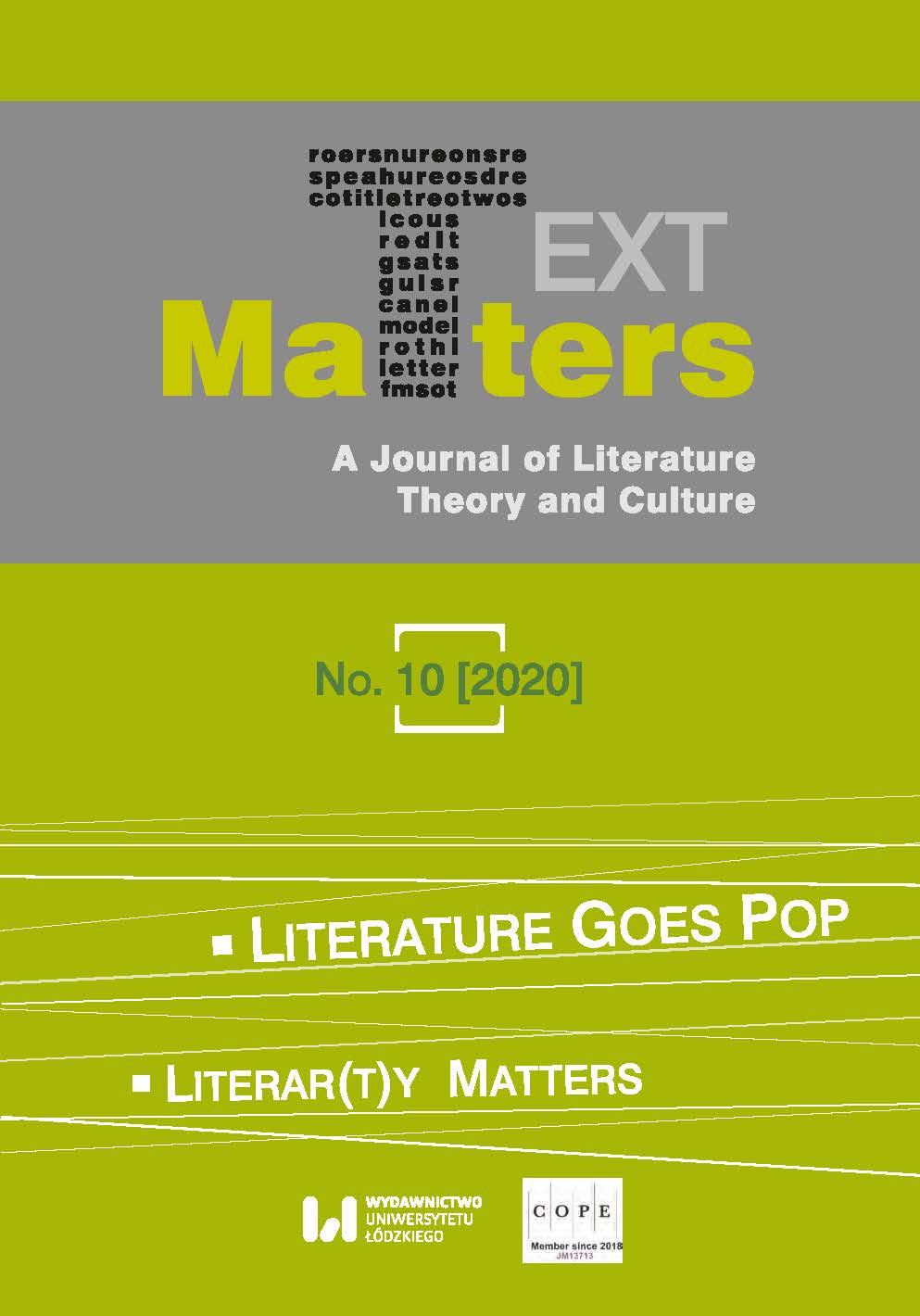Representing Absence: Contemporary Ekphrasis in “Apesh-t”
DOI:
https://doi.org/10.18778/2083-2931.10.07Keywords:
Beyoncé, Jay-Z, ekphrasis, music videoAbstract
Traditionally, ekphrasis has been defined as the description and analysis of works of art in poetry, and so it has been understood as the verbalization of visual images (Sager Eidt). The article examines the concept in the light of contemporary definitions that include non-verbal media as targets (Cariboni Killander, Lutas and Strukelj; Sager Eidt; Bruhn; Pethö) in order to analyze its applicability to music videos.
It concentrates in particular on “Apesh-t,” a video for a track by Beyoncé and Jay-Z from the album Everything Is Love (2018). The video is filmed in different interiors of the Louvre, where the singers appear, together with an ensemble of dancers, in front of selected artworks. The discussion focuses on an analysis of a single shot which presents an ekphrastic re-configuration of one particular work of European art, Jacques-Louis David’s Portrait of Madame Récamier (1800).
The author argues that the use of ekphrasis in the video—through elaboration (close-ups and editing) and repurposing of the source material (painting)—plays an important role in the construction of the theme of “absence”: invoking not only what is represented, but what is not represented in David’s painting. It also foregrounds the potential of ekphrasis as a tool of political and cultural resistance, in the way it intervenes in the representation of the “other” in art and in the museum space.
Downloads
References
“Aposiopesis.” Etymonline.com. Online Etymology Dictionary. Web. 3 Feb. 2020.
Google Scholar
Baxter, Miranda. “Seeing for the First and Last Time in Thomas Struth’s Museum Photographs.” Photographies 7.2 (2014): 201–16. Print. https://doi.org/10.1080/17540763.2014.930922
Google Scholar
DOI: https://doi.org/10.1080/17540763.2014.930922
Belting, Hans. “Photography and Painting: Thomas Struth’s Museum Photographs.” Thomas Struth: Museum Photographs. Munich: Schirmer/Mosel, 1998. 5–27. Print.
Google Scholar
Bishop, Cécile. “Portraiture, Race, and Subjectivity: The Opacity of Marie-Guillemine Benoist’s Portrait d’une négresse.” World Image: A Journal of Verbal/Visual Enquiry 35 (2019): 1–11. Print.
Google Scholar
DOI: https://doi.org/10.1080/02666286.2018.1507507
Bradley Foster, Helen. New Raiments of Self: African American Clothing in the Antebellum South. Oxford: Berg, 1997. Print.
Google Scholar
DOI: https://doi.org/10.2752/9781847888808
Bruhn, Siglind. Musical Ekphrasis: Composers Responding to Poetry and Painting. Hillsdale, NY: Pendragon, 2000. Print.
Google Scholar
Cariboni Killander, Carla, Liviu Lutas, and Alexander Strukelj. “A New Look on Ekphrasis: An Eye-Tracking Experiment on a Cinematic Example.” Ekphrasis: Images, Cinema, Theory, Media 12.2 (2014): 10–31. Print.
Google Scholar
Caticha, Alicia. “Madame Récamier as Tableau Vivant: Marble and the Classical Ideal in Beyoncé and Jay-Z’s Apesh*t.” Journal18.org. Journal18 27 Jan. 2020. Web. 12 Feb. 2020.
Google Scholar
Clüver, Claus. “Quotation, Enargeia, and the Functions of Ekphrasis.” Pictures into Words: Theoretical and Descriptive Approaches to Ekphrasis. Ed. Valerie Robillard and Els Jongeneel. Amsterdam: Vrije Universiteit UP, 1998. 35–36. Print.
Google Scholar
Elleström, Lars. Media Transformation: The Transfer of Media Characteristics among Media. New York: Palgrave Macmillan, 2014. Print. https://doi.org/10.1057/9781137474254
Google Scholar
DOI: https://doi.org/10.1057/9781137474254
Elleström, Lars. “Transmediation: Some Theoretical Considerations.” Transmediations: Communication Across Media Borders. Ed. Niklas Salmose and Lars Elleström. New York: Routledge, 2020. 1–14. Print. https://doi.org/10.4324/9780429282775-1
Google Scholar
DOI: https://doi.org/10.4324/9780429282775-1
Foucault, Michel. Discipline and Punish. London: Penguin, 1991. Print.
Google Scholar
Foucault, Michel. The Birth of the Clinic. London: Routledge, 1989. Print.
Google Scholar
Fried, Michael. Why Photography Matters as Art as Never Before. New Haven: Yale UP, 2008. Print.
Google Scholar
Grajter, Małgorzata. Personal e-mail communication with the author. 15 Feb. 2020.
Google Scholar
Heffernan, James. “Ekphrasis and Representation.” New Literary History 22 (1991): 297–316. Print. https://doi.org/10.2307/469040
Google Scholar
DOI: https://doi.org/10.2307/469040
Krieger, Murray. Ekphrasis: The Illusion of the Natural Sign. Baltimore: Johns Hopkins UP, 1992. Print.
Google Scholar
Lang, Candy. “Art History Experts Explain the Meaning of the Art in Beyoncé and Jay-Z’s ‘Apesh-t’ Video.” Time.com. TIME 19 Jun. 2018. Web. 20 Apr. 2020.
Google Scholar
Mitchell, W. J. T. Picture Theory. Chicago: U of Chicago P, 1994. Print.
Google Scholar
Pethö, Agnes. “Media in the Cinematic Imagination: Ekphrasis and the Poetics of the In-Between in Jean-Luc Godard’s Cinema.” Media Borders, Multimodality and Intermediality. Ed. Lars Elleström. Basingstoke: Palgrave Macmillan, 2010. 211–22. Print. https://doi.org/10.1057/9780230275201_15
Google Scholar
DOI: https://doi.org/10.1057/9780230275201_15
Poulter, Emma. “Black Servants in Britain.” Revealinghistories.org.uk. Revealing Histories: Remembering Slavery. Web. 20 Apr. 2020.
Google Scholar
Rosenthal, Angela, and Agnes Lugo-Ortiz. “Envisioning Slave Portraiture.” Slave Portraiture in the Atlantic World. Ed. Angela Rosenthal and Agnes Lugo-Ortiz. New York: Cambridge UP, 2013. 1–38. Print.
Google Scholar
Sager Eidt, Laura M. Writing and Filming the Painting: Ekphrasis in Literature and Film. Amsterdam: Rodopi, 2008. Print. https://doi.org/10.1163/9789401206273
Google Scholar
DOI: https://doi.org/10.1163/9789401206273
Schmidt-Linsenhoff, Viktoria. “Who is the Subject: Marie-Guilhelmine Benoist’s Portrait d’une négresse.” Slave Portraiture in the Atlantic World. Ed. Angela Rosenthal and Agnes Lugo-Ortiz. New York: Cambridge UP, 2013. 315–43. Print. https://doi.org/10.1017/CBO9781139021845.016
Google Scholar
DOI: https://doi.org/10.1017/CBO9781139021845.016
Schnapper, Antoine. Jacques Louis David 1748–1825: catalogue de l’exposition. Paris: Musée du Louvre, 1989. Print.
Google Scholar
Spitzer, Leo. “The ‘Ode on a Grecian Urn’ or Content vs. Metagrammar.” Essays on English and American Literature. Ed. Anna Hatcher. Princeton: Princeton UP, 1962. 67–97. Print. https://doi.org/10.1515/9781400877393-007
Google Scholar
DOI: https://doi.org/10.1515/9781400877393-007
Sulter, Maud. Interview by Mark Haworth-Booth. History of Photography 16.3 (1992): 263–66. Print. https://doi.org/10.1080/03087298.1992.10442557
Google Scholar
DOI: https://doi.org/10.1080/03087298.1992.10442557
“Thomas Struth: Museum Photographs.” Phillips.com. Phillips 24 Oct. 2016. Web. 28. Mar. 2020.
Google Scholar
Thompson, Krista. Shine: The Visual Economy of Light in African Diasporic Practice. Durham: Duke UP, 2015. Print. https://doi.org/10.1215/9780822375982
Google Scholar
DOI: https://doi.org/10.2307/j.ctv125jt5r
Tuchman, Phyllis. “On Thomas Struth’s ‘Museum Photographs.’” Artnet. com. Artnet 15 Mar. 2014. Web. 20 Feb. 2020.
Google Scholar
Vernallis, Carol. “Tracing the Carters Through the Galleries.” Journal of Popular Music Studies 30.4 (2018): 25–42. Print. https://doi.org/10.1525/jpms.2018.300403
Google Scholar
DOI: https://doi.org/10.1525/jpms.2018.300403
Wylie, Charles. “A History of Now: The Art of Thomas Struth.” Thomas Struth 1977–2002. New Haven: Yale U Art Gallery, 2002. 147–55. Print.
Google Scholar
Downloads
Published
How to Cite
Issue
Section
License

This work is licensed under a Creative Commons Attribution-NonCommercial-NoDerivatives 4.0 International License.













